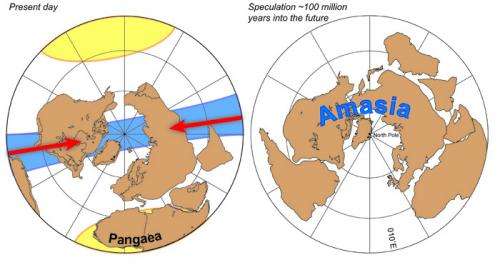Amasia: As next supercontinent forms, Arctic Ocean, Caribbean will vanish first

(PhysOrg.com) -- Geologists at Yale University have proposed a new theory to describe the formation of supercontinents, the epic process by which Earth’s major continental blocks combine into a single vast landmass. The new model radically challenges the dominant theories of how supercontinents might take shape.
In a paper published Feb. 9 in the journal Nature, Yale researchers introduce a process called orthoversion, in which each succeeding supercontinent forms 90 degrees from the geographic center of its ancient predecessor. Under the theory, the present-day Arctic Ocean and Caribbean Sea will vanish as North and South America fuse during a mutual northward migration that leads to a collision with Europe and Asia.
“After those water bodies close, we’re on our way to the next supercontinent,” said Ross N. Mitchell, the Yale doctoral student who is the paper’s first author. “You’d have the Americas meeting Eurasia practically at the North Pole.”
The researchers do not speculate in the paper when the next supercontinent, named Amasia for its union of America with Eurasia, will emerge, but the event is far distant — between 50 million and 200 million years away, Mitchell said.
The new theory contrasts with the standard theories about supercontinent formation, introversion and extroversion, which hold that supercontinents form either 0 or 180 degrees away from the geographic center of the previous supercontinent. Under these earlier theories, the Atlantic Ocean will disappear and the next supercontinent will form with a center more or less in the same spot as the last supercontinent’s center (present-day Africa), or, alternately, the Pacific Ocean will disappear and the next supercontinent will form with a center on the opposite side of the globe.
Mitchell and colleagues arrived at the new theory after an extensive analysis of the magnetism of ancient rocks. After each historical supercontinent assembled, it underwent a series of back-and-forth rotations around a stable axis along the equator. From one supercontinent to the next, the axes were offset from each other by about 90 degrees, the Yale team showed — consistent with orthoversion, but not with either introversion or extroversion.
“This kind of analysis gives us a way to arrange continents in both latitude and longitude, providing a better understanding in patterns of biological dispersal and the dynamics of Earth's deep interior,” said Yale doctoral student Taylor M. Kilian, the study’s second author.
The most recent supercontinent, Pangea, formed about 300 million years ago with Africa at its center. It began breaking apart into the seven continents of today with the birth of the Atlantic Ocean about 100 million years later. Researchers believe Pangea is the third or fourth supercontinent in Earth’s history. Its immediate predecessors were Rodinia (which formed about 1 billion years ago) and Nuna (which formed about 1.8 billion years ago). The paper’s senior author, Professor David A.D. Evans of Yale, has devoted most of his career to studying the internal arrangements of the Earth’s continental blocks.
Under the orthoversion model, either Asia or North America would become the center of Amasia, in a spot currently occupied by the Arctic Ocean. A newly formed mountain range will stitch them together.
“Such speculations far into the future cannot be tested by waiting around 100 million years, of course,” Evans said, “but we can use the patterns gleaned from ancient supercontinents to think deeply about humanity’s current existence in time and space within the grand tectonic dance of the Earth.”
More information: Supercontinent cycles and the calculation of absolute palaeolongitude in deep time, Nature 482, 208–211 (09 February 2012) doi:10.1038/nature10800
Abstract
Traditional models of the supercontinent cycle predict that the next supercontinent—‘Amasia’—will form either where Pangaea rifted (the ‘introversion’1 model) or on the opposite side of the world (the ‘extroversion’2, 3, 4 models). Here, by contrast, we develop an ‘orthoversion’5 model whereby a succeeding supercontinent forms 90° away, within the great circle of subduction encircling its relict predecessor. A supercontinent aggregates over a mantle downwelling but then influences global-scale mantle convection to create an upwelling under the landmass6. We calculate the minimum moment of inertia about which oscillatory true polar wander occurs owing to the prolate shape of the non-hydrostatic Earth5, 7. By fitting great circles to each supercontinent’s true polar wander legacy, we determine that the arc distances between successive supercontinent centres (the axes of the respective minimum moments of inertia) are 88° for Nuna to Rodinia and 87° for Rodinia to Pangaea—as predicted by the orthoversion model. Supercontinent centres can be located back into Precambrian time, providing fixed points for the calculation of absolute palaeolongitude over billion-year timescales. Palaeogeographic reconstructions additionally constrained in palaeolongitude will provide increasingly accurate estimates of ancient plate motions and palaeobiogeographic affinities.
Journal information: Nature
Provided by Yale University



















